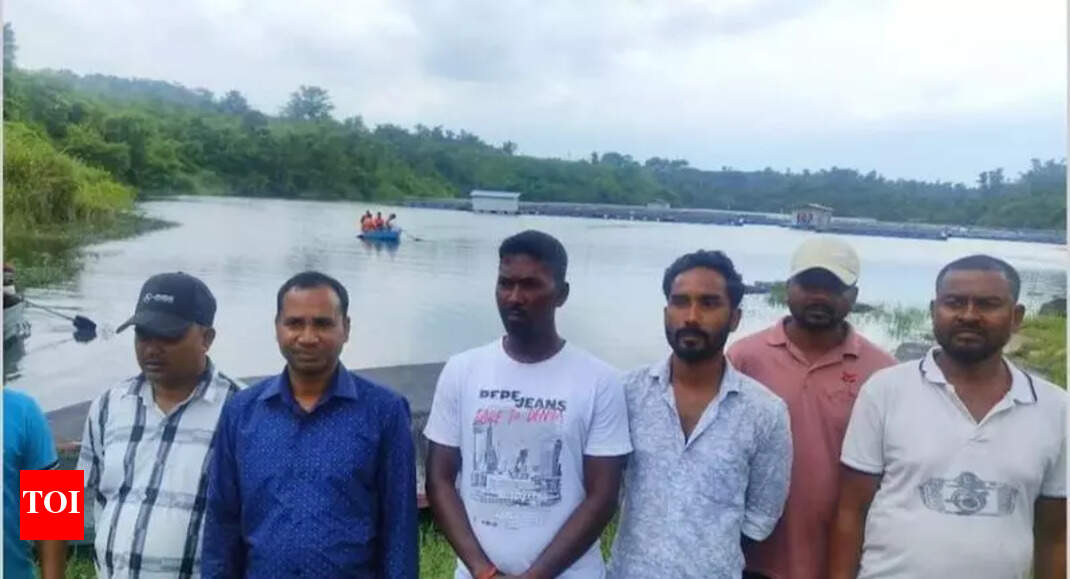World
Villagers in Ramgarh Transform Abandoned Coal Mines into Fish Farms

In Ramgarh, India, villagers are turning abandoned coal mines into thriving fish farms, significantly impacting the local economy. Shashikant Mahto, a resident of Kujju, has leased two disused coal mines from the department of fisheries for fish farming. These mines, left by the Central Coalfields Limited (CCL) after coal extraction, have become reservoirs of water that are ideal for raising fish.
Mahto, 38, has focused on mines number 8 and 13 located in the Ara area. He noted that the abandoned sites offer advantages over traditional ponds and lakes. “The abandoned mines are beneficial for fish farming as compared to ponds, lakes, and other reservoirs as the fishes are safe from becoming prey of snakes and birds in mines,” he explained. The fish he raises typically weigh between 4 kg and 7 kg.
In 2010, Mahto received a reward of ₹5,000 and a pisciculture cage from the fisheries department for successfully rearing a 15 kg katla fish. He introduced the first cage in Ramgarh and sought guidance from the Kujju Matsyajeevi Sahayog Co-operative Society and the fisheries department to initiate fish farming in the coal mine. Observing that water from a nearby pond overflowed into the abandoned mine during the monsoon, he realized that fish were thriving in that environment.
Mahto’s partner, Bhushan Prasad, highlighted the collaboration among local fish farmers. “We, 74 fish farmers, formed a co-operative society in 2012. Today, the society consists of 40 members,” he stated. This cooperative structure has bolstered fish farming efforts and community support.
The fish produced, including rohu, katla, and tilapia, are sold in nearby districts such as Bhabhua, Sasaram, and Gaya in Bihar. Mahto reported that the mines, which reach depths of about 200 to 250 feet, are particularly suitable for fish farming, as fish typically remain above 25 feet. The farmers catch fish using nets cast to a depth of 15 feet. Currently, they maintain around 100 cages, each measuring 6×8 feet, yielding an impressive annual output of 70 tons of fish, alongside an additional 4 to 5 tons from pits.
According to Arup Choudhary, the district fishery officer, the integration of abandoned coal mines into the local fish farming industry could serve as a major boost for Jharkhand’s fish production. He noted that farmers involved in this venture are earning an average of ₹2 lakh per year, contributing to the economic upliftment of the community.
H N Dwivedi, the state director of fisheries, emphasized the significance of using these coal mines for aquaculture. He stated, “Rearing fish in coal mines is a big deal in terms of taking Jharkhand ahead as a producer of fishes.” With over 100 abandoned mines available, the state is currently utilizing 25 for fish farming across various districts, including Ramgarh, Chatra, Dhanbad, and Bokaro.
The potential for fish farming in these mines is substantial, with reports indicating that each mine could yield up to 100 tons of fish. This innovative approach not only enhances fish production in Jharkhand but also improves the livelihoods of local residents, transforming the economic landscape of the region.
-

 World5 months ago
World5 months agoSBI Announces QIP Floor Price at ₹811.05 Per Share
-

 Lifestyle5 months ago
Lifestyle5 months agoCept Unveils ₹3.1 Crore Urban Mobility Plan for Sustainable Growth
-

 Science4 months ago
Science4 months agoNew Blood Group Discovered in South Indian Woman at Rotary Centre
-

 World5 months ago
World5 months agoTorrential Rains Cause Flash Flooding in New York and New Jersey
-

 Top Stories5 months ago
Top Stories5 months agoKonkani Cultural Organisation to Host Pearl Jubilee in Abu Dhabi
-

 Sports4 months ago
Sports4 months agoBroad Advocates for Bowling Change Ahead of Final Test Against India
-

 Science5 months ago
Science5 months agoNothing Headphone 1 Review: A Bold Contender in Audio Design
-

 Top Stories5 months ago
Top Stories5 months agoAir India Crash Investigation Highlights Boeing Fuel Switch Concerns
-

 Business5 months ago
Business5 months agoIndian Stock Market Rebounds: Sensex and Nifty Rise After Four-Day Decline
-

 Sports4 months ago
Sports4 months agoCristian Totti Retires at 19: Pressure of Fame Takes Toll
-

 Politics5 months ago
Politics5 months agoAbandoned Doberman Finds New Home After Journey to Prague
-

 Top Stories5 months ago
Top Stories5 months agoPatna Bank Manager Abhishek Varun Found Dead in Well









